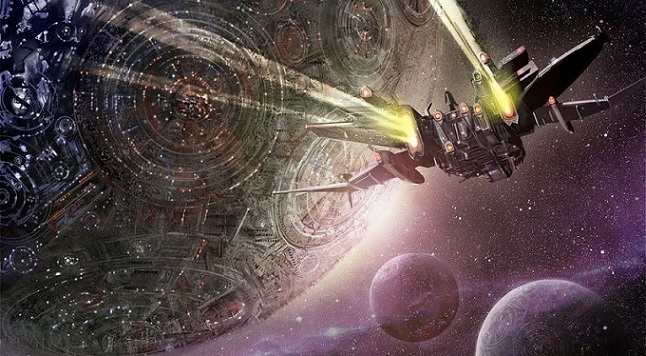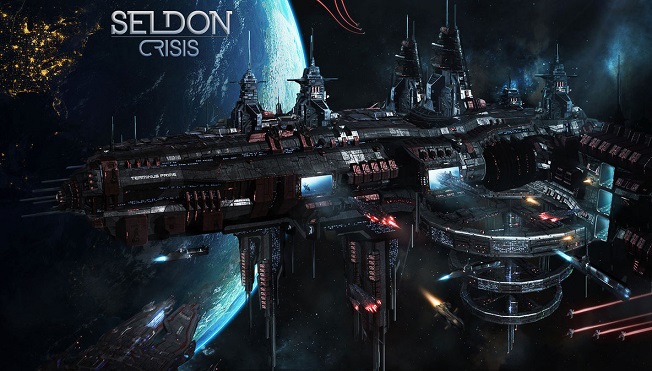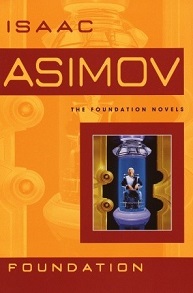Review: Foundation

“The whole war is a battle between those two systems; between the Empire and the Foundation; between the big and the little.”
What if seeing into the future was a matter of algorithmic precision? If we could model behavior on large scales with pinpoint accuracy, might we then predict the actions of nations, the collapse of empires, the bends and undulations of history? In Asimov’s far future (~50,000 years time), our science can do that and more, with the ability to reduce the aggregate behavior of billions to mathematical formulae and compute probable paths civilization will take. Conceived by Asimov’s fictional luminary Hari Seldon, the science of psychohistory uses the “law of mass action,” together with psychological, sociological and mathematical techniques, to predict macro-historical developments. In perhaps no other context could the phrase “knowledge is power” be more fully realized.
Unleashed from its fitfully habitable home planet, humanity tore out across the stars, occupying millions of worlds, all connected under one vast Galactic Empire. The Empire has endured through twelve thousand years of relative peace among the distant and thriving ecumenes under its rule. But the great Seldon foresees dark times ahead. His research has matured in scope and scale, revealing to a mathematical certainty that the current Empire will fall, and a new regime will rise in its place, but not before a harrowing period of turmoil and barbarism lasting thousands of years. As chief bellwether of galactic catastrophe, Seldon is labeled an agitator and tried for treason, though eventually he wins over the judges at his tribunal with the force of argument.
Seldon uses his knowledge of the future to devise plans to shorten the interregnum of chaos that will inevitably follow the Empire’s collapse. He obtains a charter for establishing the Foundation on the remote peripheral planet Terminus, ostensibly to safeguard the collective knowledge of the human race. A second Foundation is also set up at the opposite or “Star’s End” of the galaxy (though precious little is disclosed about this group for reasons that become clear as you make your way through the series). Teams of scientists and scholars specially selected by Seldon are assembled on Terminus for the express purpose of compiling the Encyclopedia Galactica — a monomaniacal endeavor shrouded in suspicion and uncertainty.
It doesn’t take long before the “Encyclopedists” are embroiled in the first of several major crises to challenge the Seldon Plan. The underlying question — and one that will reemerge time and again throughout the series — is whether Seldon, in all of his psychohistorical prowess, accounted for every contingency that arises to threaten the resilience of the Foundation and its subjects. Might there be certain fortuities that lay beyond the reach of his science? Will the pair of Foundations, forearmed by Seldon’s prescience, surpass each generational obstacle that comes their way? Or more concisely, just how comprehensive was Seldon’s genius? This dramatic tension between the inevitability of history and the futility of individual action is one that nags and inspires and, as it turns out, is far more compelling than the characters Asimov created and the world they inhabit.
Which is to say that if the plot outlined above fails to fire the imagination, it’s likely nothing else in Asimov’s Foundation saga will hook you. The writing is mostly dry, the characters hopelessly bland and homogeneous, the dialogue stodgy and robotic, and the overall story loose and disjointed. The first book, especially, suffers from an egregious case of character uniformity. Hari Seldon, Salvor Hardin, and Hober Mallow all come across as virtually identical on the page: Seldon’s plea to the board on Trantor; Hardin’s heated debate with colleagues before accessing the Vault for the very first time; Mallow’s pro se defense on Terminus; all are polished perorations reminiscent of an academic conference. In fact, if you were to excerpt random samples of their dialogue and present them to someone who hasn’t read the book, I suspect they would not be able to tell them apart. And that’s because for Asimov, dialogue is much more about advancing the plot and dissecting ideas than elaborating or individuating his characters.
Storytelling is also hampered by a staccato structure which jumps from one character and era to an entirely different time and place, with seemingly no bridge in between. Just as you grow familiar with one group of names and their goings-on, you are transported to the distant future and introduced to the next Xeroxed avatar who formulaically plays out Seldon’s statistical prophecy. I get it, though: Asimov’s psychohistorical drama spans several centuries, and each successive crisis entails a new configuration of players and technologies. But the more continuity you expect, the more jarring each new chapter feels. One might contend that it’s this grand scale that lets Asimov off the hook for the utter lack of character development; after all, why commit to chasing character arcs when they’ll be made anew a few pages on? And yet, what narrative, space epic or no, hasn’t benefited from a memorable character or two?
I later learned of two explanations for the literary mediocrity on display. The first is that Foundation isn’t actually a stand-alone novel, but a compilation of serialized short stories published independently. Only later were they smooshed together into the final form appearing in paperback. The second is that these were among Asimov’s first entries in the science fiction space. He was young and still honing his craft, but went on to write progressively better books. Though I’ve not made it through the whole series, I can vouch that the second and third are appreciably superior to the first, with more focused plotting and consistent delivery.
Closing Thoughts
I dearly expected more from such a highly revered author and series. Not in terms of plot, mind you, which is a fitting showcase of Asimov’s unmatched brilliance and which actually kept me up at night as I turned over its intricacies and scanned for possible loopholes. Indeed, the implications of psychohistory give way to some truly staggering thought experiments when explored in the abstract and deep dissections when viewed through the lens of Asimov’s world, as this essay by Mark Rosenfelder illustrates (#majorspoilers).
Rather, my gripes tend to be more of a literary nature revolving around Foundation‘s undimensional characters and stiff-as-cardboard dialogue. Believe it or not, a novel that’s at least 85% dialogue through which you learn almost nothing about the unrelatable characters can make for quite a displeasing reading experience. Worse, when your protagonists all run together, you risk losing the reader’s interest not just in the characters themselves but in the overall narrative, no matter how strong on its own terms. To enjoy this novel, I essentially had to switch off the part of my brain that expects proper characterization and simply focus on the general direction of the plot. Knowing the characters didn’t matter so much in the grand scheme of things helped pad my will to continue down Seldon’s rabbit hole.
Whether or not you wish to take the plunge depends ultimately on whether you, like Asimov, favor mind-warping ideas to riveting characters and poetic prose.
Note: This review is mirrored over at Goodreads and at Amazon.
Further reading:




Comments